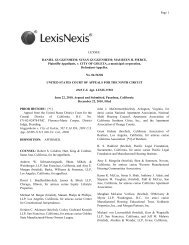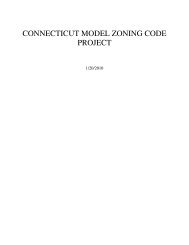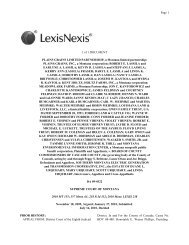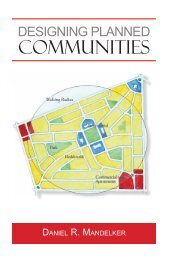Through a Glass Darkly: Measuring Loss Under ... - Land Use Law
Through a Glass Darkly: Measuring Loss Under ... - Land Use Law
Through a Glass Darkly: Measuring Loss Under ... - Land Use Law
You also want an ePaper? Increase the reach of your titles
YUMPU automatically turns print PDFs into web optimized ePapers that Google loves.
MEASURING LOSS UNDER MEASURE 37 589<br />
the standard appraisal methods yields the value of an individual exemption rather<br />
than the reduction in value due to regulation. Given that some of the limiting factors<br />
in our analysis tend to overstate property values in the no-regulation scenario, it is not<br />
clear whether the change in value due to the regulation is positive. The estimates of<br />
reduction in value due to regulation are negative for unzoned land located outside the<br />
zoned district suggesting that the three resource protection zoning regulations<br />
increase the value of unzoned lands by $1552 to $156,116 per acre on average.<br />
Hence, while the resource protection policies may reduce the value of the regulated<br />
lands, these policies often increase the value of unregulated lands. 99<br />
There are also those positive reinforcement roles of land use regulations<br />
in limiting spatial externalities of private unregulated land use<br />
activities, as well as providing benefits accruing from coordinating<br />
infrastructure installation and location of uses where they will have the<br />
greatest social effects (none of which are usually considered in the<br />
“loss” calculus under Measure 37). Hascic and Wu infer that a more<br />
sophisticated model would consider these calculations as well in determining<br />
any net “loss” of property value. 100 Such a model is both consistent<br />
with the wording of Measure 37 (as is suggested in the analysis<br />
below), but is also vastly more accurate than the prevalent exemption<br />
model most often used for calculations of loss in value throughout Oregon.<br />
The principle defect of the model is its impracticality of use, 101<br />
although it is also controversial in economic circles, as discussed immediately<br />
below.<br />
D. Criticism of the Hascic and Wu Method<br />
There are a number of criticisms from an economic standpoint that can<br />
be made of the Hascic and Wu method. The first and most potent economic<br />
criticism of their model is that their equation for establishing the<br />
hypothetical land value entirely ignores the effect of supply and demand<br />
relationships on the value of land. As we have seen, land use regulations<br />
can have a dramatic effect on land prices by increasing or decreasing<br />
99. Hascic & Wu, supra note 77, at 89.<br />
100. If the analysis were limited to an “all-but-the-selected-regulation” basis, the<br />
authors suggest the “loss” of value would be greatly reduced. However, the exemption<br />
method would place a premium beyond any actual reduction in value arising out of the<br />
use of natural resource zoning or the use of an urban growth boundary. Hascic & Wu,<br />
supra note 77, at 93.<br />
101. William K. Jaeger, associate professor of agricultural and resource economics<br />
at Oregon State University, suggests the “with and without” selected regulation approach<br />
comes up with the correct result, but is “complex, costly[,] requires detailed economic<br />
model[ing] [and is] difficult to validate.” Jaeger and his academic colleague, Andrew<br />
Plantinga, proposed their own methodology, described herein, as a more easily administered<br />
process for evaluating claims, while acknowledging that it has only a 75% accuracy<br />
rate. See William K. Jaeger, Three Methods for Evaluating Measure 37 Claims,<br />
EM 8933-E OR. STATE UNIV. EXTENSION SERV. (2007), available at http://extension.<br />
oregonstate.edu/catalog/pdf/em/em8933-e.pdf.<br />
ABA-TUL-07-0701-Sullivan.indd 589<br />
9/18/07 10:43:41 AM







